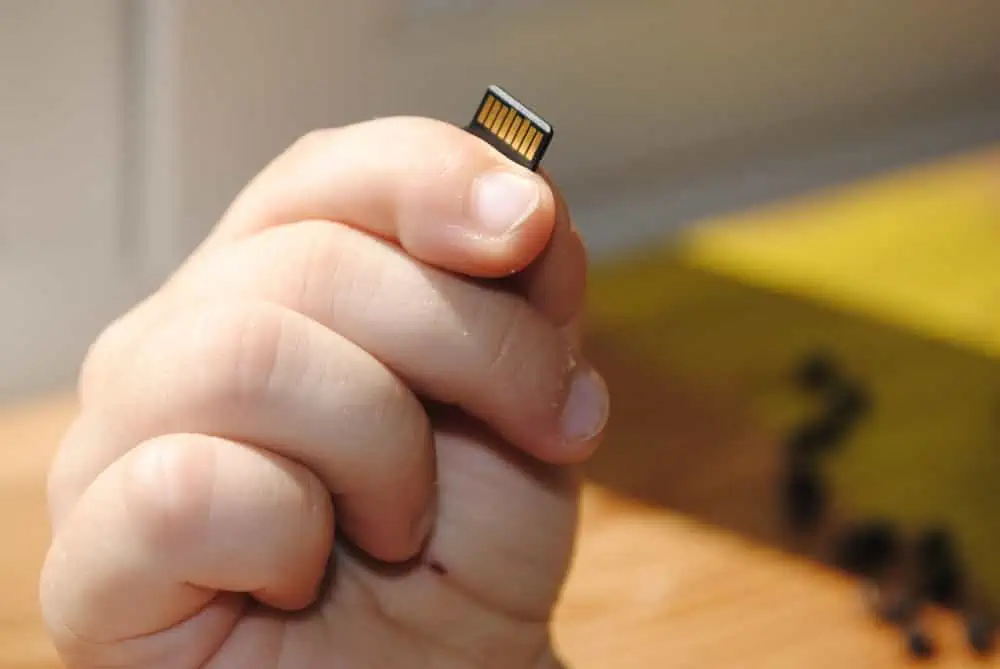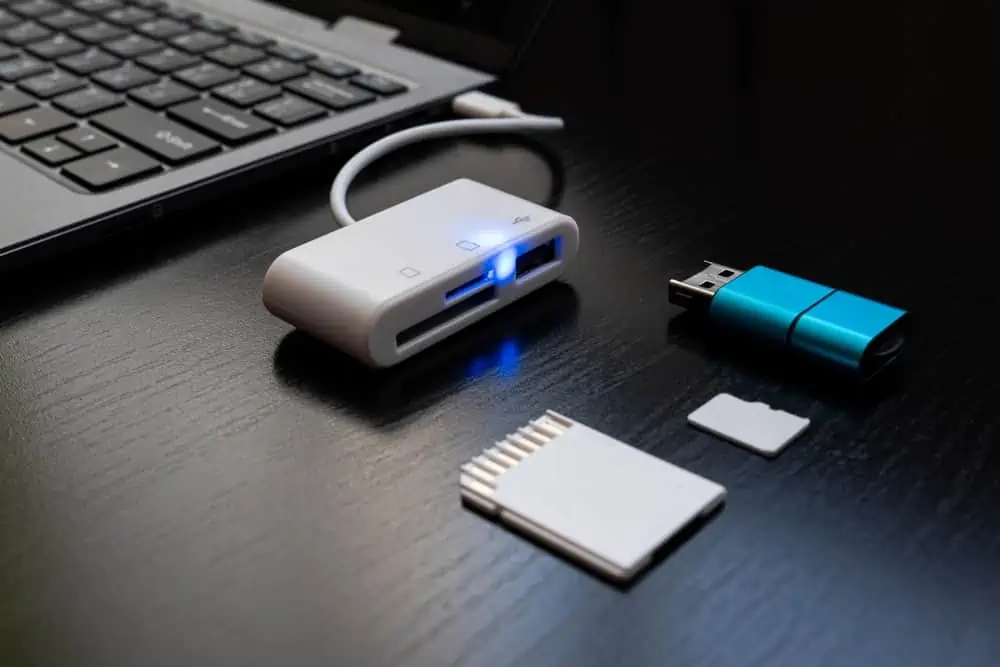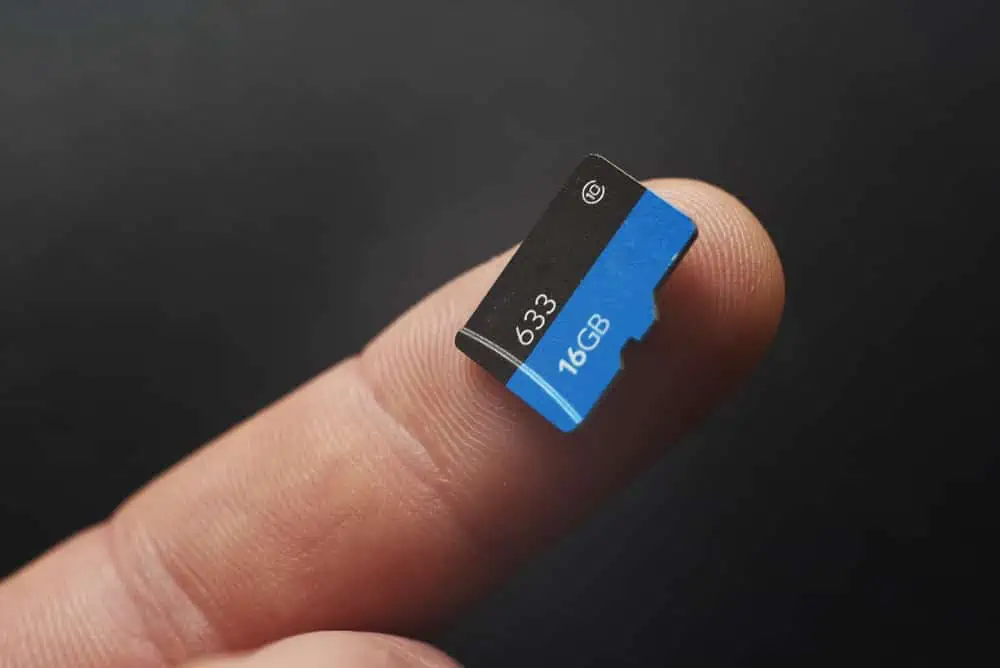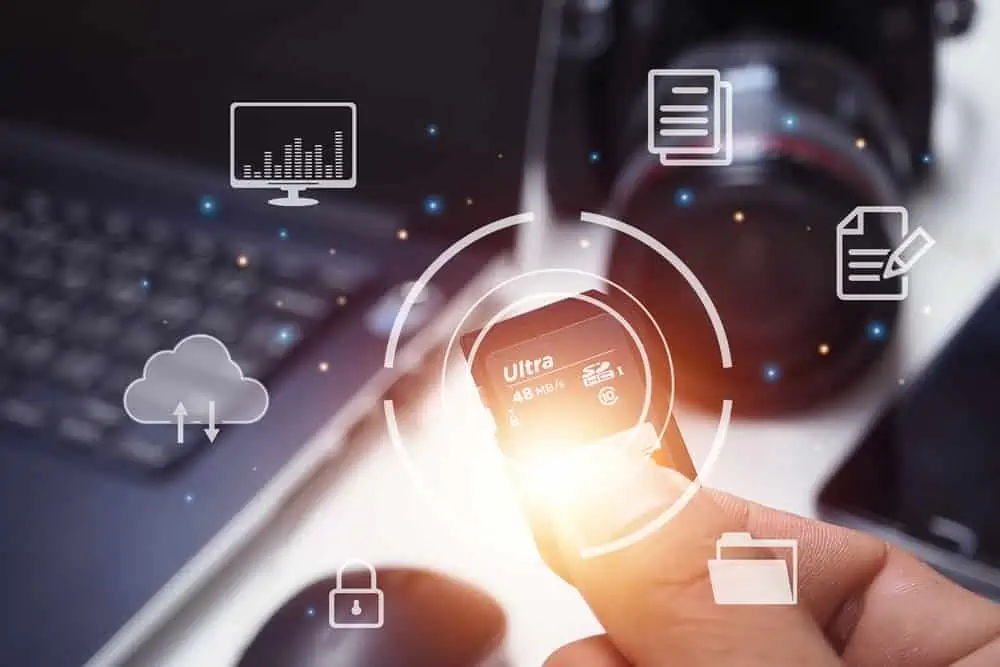Are you curious to learn how flash storage differs from SSDs and HDDs? You’re not alone, but I offer a simple but detailed explanation of this storage technology in this guide.
Overview
Flash storage is mainly a solid memory card or some microchips connected to a USB stick for storing data. Whichever form it comes in, this storage saves and reads data at a very high speed – the speed of a “Flash.”
Originally, Toshiba invented flash storage in 1980 using memory components that you can only wipe and rewrite electronically. Thus, if you just remove such storage from its host device, it doesn’t lose the data in it.
Today you will find this storage in many devices, including digital cameras, laptops, and smartphones. In digital cameras, they come as memory cards, while laptops have them as USB flash storage sticks.
In each case, reading and writing data will be fast, and you can remove the storage without losing its data.
Technology-wise, flash storage is based on EEPROM (electrically erasable programmable read-only memory). Now that I have given an overview of this storage technology, I will explain how it works in the next section.
How Does Flash Storage Work?
Flash storage drives save or store data using EEPROM – a memory chip comprising NAND and NOR logic gates. These logic gates (electronic chips) allow a certain amount of voltage to pass through them to store or delete data.
NAND-based EEPROM is the most common type of flash memory in USB flash drives, SD cards, and SSD storage. Besides the memory chip (EEPROM), flash storage also has a storage controller chip, a crystal oscillator, and a write-protect switch.
When you plug a USB drive into a computer, the computer sends electrical signals into the flash drive. On receiving the signal, the storage controller on the flash drive gives the computer’s processor access to the flash memory.
Also, the storage controller formats the storage (rearranges the data in the memory) into a structure that machines can understand.
On the other hand, the crystal oscillator is just a clock chip in the storage which takes care of the timing. So, the crystal oscillator determines the speed at which the other components work, thereby affecting a flash thumb’s read/write speeds.
Moreover, some SD cards and USB sticks have a write-protect switch – a small switch you can slide on or off. When you slide it on, it will prevent you from accidentally formatting your flash memory.
Not only that but sliding the write-protect switch on also stops viruses from infecting the files saved in the drive.
Features of Flash Storage Technology
In the previous sections, I discussed the overview of flash storage. Also, I looked at how this storage technology works.
Now, I’m going to highlight some important features of this storage technology below. One thing you should note is how the features I’ll be highlighting below make a flash thumb similar and different from other storage types.
Flash Storage is a Solid-State Storage Device
Already, I have mentioned this feature in the overview section. Regarding this feature, this storage technology does not have any moving parts like spinning disks.
Therefore, it is quite different from hard disks (for example, HDDs and SSHDs), which have spinning disks.
However, this feature makes it more like an SSD (solid-state drive) storage.
It is a Non-Volatile Storage Drive
Flash storage drives retain and maintain the quality of their data when there is no electrical power in them. Hence, a sudden shutdown of a smartphone, laptop, or digital camera cannot delete the data in its flash memory.
Remember, this storage type stores data using EEPROM. As I mentioned earlier, EEPROMs are based on floating NAND gates that do not turn off except on special occasions.
So, you can turn its host device off, and you can as well unmount (unplug) it from the host device. After a long time, you can put it back, and you’ll see that you still have the documents you saved in the drive.
This is the same reason the chips on credit cards and SIM cards do not lose their data when removed from Smartcard readers or phones. Also, SD cards and USB sticks don’t have to remain plugged into phones or laptops to retain the data in them.
Its Memory (EEPROM) is Electrically Programmable
The contents of a floating gate EEPROM can be wiped off and rewritten. However, this requires sending a special electrical signal or voltage through one of the wires connecting it.
More specifically, passing the voltage can remove its data in units called blocks. Also, sending such voltage into the wire can write data into the memory in another unit called bytes.
Although you can rewrite EEPROM, the more you wipe and rewrite it, the closer you get to the end of its lifespan (approximately 10,000 times).
Varying Size and Storage Capacity
The physical sizes and storage capacities of flash storage drives vary greatly. This, however, depends on the type of data being stored and the size of individual data files.
For example, Smartcards are wide and thin in size. However, the memory chip on Smartcards may have a storage capacity ranging from 8 KB up to 256 KB.
That is because smartcards are meant to store a small amount of data. For instance, they store data such as PINs (Personal Information Numbers), names, and phone numbers.
Furthermore, memory cards are small in dimension, measuring 32 x 24 mm (full-size SD cards) and 15 x 11 mm (Micro SD cards). Despite that, memory cards have a high storage capacity for storing images, songs, videos, and larger files.
So, just like USB drives, you can find SD cards of 8 GB, 16 GB, and up to 1 TB of storage space.
Low-cost
Generally, Smartcards, SD cards, and USB storages are highly affordable. In part, this is due to their small sizes and the build material for their memory chip.
Speaking of their memory chip, NAND flash memory is made from silicon, and silicon is obtained from the sand. As we all know, sand is a readily available raw material, so the cost of processing the sand is what matters (I know that I have oversimplified this, but you get the gist!).
This is why compared to other storage types, flash storage is cheaper. For instance, a 16 GB USB flash drive will cost less than a hard disk drive with an equivalent capacity.
Also, when we talk about cost, it goes beyond the selling price of the storage. Beyond that, the operational cost is an essential factor as well.
Regarding operational costs (energy requirement), SD cards consume less energy than SSDs and HDDs.
Pros of Flash Storage
Flash Storage is Affordable and Cheaper Than SSDs
SanDisk, USB drives, and smartcards are highly affordable, unlike SSDs which usually cost much to buy.
Fast Transfer Speed
It does not take much time when you copy pictures, audio, or video files from or to SD cards. The same thing happens when you copy files from or to a USB storage drive.
Appreciably, this is possible because the memory on such storage is read from and written to using electrical signals. On the other hand, electrical signals travel at high speed.
Higher Capacity Compared to its Small Size
The capacity of flash storage can be quite higher than its physical size. More precisely, you can get a flash drive of 512 GB capacity or even a terabyte capacity.
Likewise, SD (Secure Digital) cards can be up to 2 GB, and SDXC (Secure Digital eXtended Capacity) can reach up to 2 TB. Also, SDUC (Secure Digital Ultra Capacity) can be up to 128 TB.
Surprisingly, the physical size of such a flash card or USB drive can be a quarter or less of an equivalent HDD.
Increased Durability
Because it doesn’t have any moving parts, flash storage doesn’t wear away quickly. Thus, this eliminates the possibility of a component shaking and pulling off.
Compatibility with Many Devices
Unlike HDDs and SSDs, the use of flash storage is not limited to bigger gadgets like laptop computers. Besides laptops and desktops, this storage technology is also compatible with many smaller electronics.
So, you will find devices such as digital cameras, Smartphones, MP3 players, and USB drives featuring this storage technology.
Cons Of Flash Storage
A Limited Number of Reads/writes Before Failing
Flash storage does not live forever. The more you wipe its content and save new data, the closer it gets to the end of its life.
Usually, the lifetime of a flash memory drive is about 10,000 times of erase/rewrite cycle.
It is Easy to Lose Due to its Small Size
No doubt, memory cards, and USB sticks do have small dimensions. Thus, it is very easy to misplace them or cover them with other stuff thereby resulting in their loss.
Probably, you have heard of a professional losing a USB flash drive with sensitive contents in a plane or taxi.
Vulnerable to Physical Damage
SD cards can break, and the connector of USB sticks (USB jack) can pull if you mishandle them. These physical damages eventually lead to the operational failure of the storage.
Nevertheless, its vulnerability is not higher than that of HDDs and SSHDs with moving parts.
They are Capable of Transferring Malware from One Device to Another
Malicious software can copy itself from a laptop into a flashcard or a USB drive. Consequently, inserting such storage on another device opens the way for infecting the new device.
It Does Not Support Distributed Access
Only the device in which you plug a media card or a USB drive can access it at a time. Hence, multiple users can not access it concurrently.
Conclusion
Flash memory drive guarantees high portability, fast read/write speed, and less power consumption. Thus, we see memory cards and USB flash drives mainly on small devices that run on batteries.
For example, digital cameras and smartphones use it as their primary storage since they all rely on battery power. Moreover, laptops and tablets too can feature SDXC (Secure Digital eXtended Capacity) cards or USB storage drives for storage expansion.
Impressively, the capacity of a flash thumb drive can be small and can be extremely large as well. Despite their small physical dimensions, SDXCs and SDUCs can compete with the bigger hard drives in terms of storage capacity.
In conclusion, flash memory storage has many benefits now, and it promises more in the future. Therefore, why don’t you get one for yourself and anticipate the future with high hopes?
I hope I was able to explain flash storage and how it compares to other types of storage. I also hope that you found the article easy to understand and helpful.
If you did, click on “Yes” beside the “Was this page helpful” question below. You may also express your thoughts and opinions by using the “Leave a Comment” form at the bottom of this page.
Finally, you may find other helpful articles on our Storage & Disk Technology Explained page.



